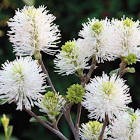The plant of the month is fothergilla. It is so designated because we now have one large plant and many suckers courtesy of our donor extraordinaire John. The large plant was 3 feet tall and very heavy. We rolled it off the truck and into a hole so hopefully it will adapt and provide us with new plants for many years to come. Some of the suckers were potted up for the plant sale and there are still a number in water if anyone wants them. If they don’t go by the end of the month I’ll put them in the ground for future reference.
So let us look at the fothergilla. This plant is native to the south east US and has a rather limited range. Fothergilla major in fact is on the threatened species list in Georgia and Tennessee. It is a swamp or woodland plant. It is hardy between zones 3 and 8. This plant is difficult to find in our region and consequently is underutilized in northern gardens. John brought this one back from North Carolina and it was doing well in his yard. We are not sure of the species or cultivar but as John says it was simply labeled “fothergilla.” We will be looking into ways to at least make an educated guess. Currently, it is leafless and dormant so size is about all we have to go on.
Fothergilla is a member of the Hamamelidaceae family, as is our native witch hazel ((Hamamelis virginiana). Its common name is witch alder. There are three or perhaps two species of fothergilla. The taxonomists haven’t yet decided. The most common species is Fothergilla gardenii or Dwarf fothergilla. This plant is only 1’ to 2’ in height and suckers freely, often making large clumps. Gardenii is the parent plant for a number of cultivars. ‘Blue Mist’ is probably the most popular. It 2’ to 3’ tall and was breed for the blue color of its leaves. The fall color, according to the University of Connecticut, may not live up to the high standard set by some of the other fothergilla. ‘Klmtwo’ BEAVER CREEK is another small one at 2’-3’. It has a blue/ green summer foliage and tends to fall colors in the red range. “Jane Platt’ was bred as a spreader; it grows to two feet with large flowers. The fall display is described as good but not spectacular.
Fothergilla major is the larger fothergilla. It averages around 8’ tall and can reach 10\’ under ideal conditions. It is equally robust in diameter but is a rather slow growing plant. The flowers are larger than the dwarf fothergilla, ‘Mt. Airy is the most popular of the cultivars of F. major. It is a smaller plant averaging between 3’-5’ and is said to be an overall improved bush both in flowering and fall color. ‘Blue Shadow’ was bred from ‘Mt. Airy’ and combines the best of ‘Mt Airy’s’ qualities with a blue leaf color. It is about 5’ in height.
Fothergilla monticola is the third species, although some taxonomists discredit it as not being sufficiently different from F. major to be a different species. It is a multi-stemmed shrub that reaches about 6’ tall. . ‘Klmsixteen’ MAY Bouquet is considered to be F. monicola. It takes 10 years to reach its maximum size of 6’x4’. The fall colors are brilliant ranging from yellow through orange and red. This one occasionally blooms in the fall as well as in the spring. The leaves are waxier than the other species and are green on top with a slight blue cast to the underside.
There are other cultivars of fothergilla and new ones are being introduced every day. These are the most readily available ones where they are available at all. Frequently, they are simply sold as unnamed plants and presumably are the native plants or unnamed hybrids.
As it is probably plain at this point that the fothergilla is grown both for the flowers and the spectacular fall colors. The flowers are always white and are monecious with the male and female flowers, both found in the bottle brush inflorescence. The petals are non-existent and it is the male stamens that make up the showy white flowers. The flowers are particularly conspicuous because the bushes flower in April before the leaves emerge. The flowers are highly fragrant and the abundance of them makes their honey scented perfume evident over long distances. Fall foliage colors range from yellow and orange through shades of red to burgundy and maroon. Different cultivars produce different fall colors and many have been bred for autumn display. Climate and conditions will also affect the fall color display.
- gardenii and its cultivars are less hardy and fussier than F. major and its derivatives. The maximum range is zone 5. Some of the verities are more likely to succumb to our colder winters than the native plant. These lower growing plants like constantly moist but well drained soil. They do not like standing water and need an acid soil. F. major is more reliably hardy to zone 4. It too prefers organic soil that is moist but well drained but will tolerate a heavier soil and drier conditions. Both flower best in full sun in northern conditions but will tolerate some shade.
These plants are not native to our area but there is a good possibility that under the right conditions they will thrive. Fothergilla is a beautiful, unusual and underutilized plant. Perhaps it will become more popular as people realize what a maintenance free, unique plant it really is
